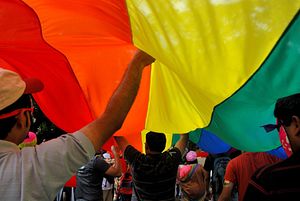On January 10, 2018, India’s Supreme Court declared it would re-examine Section 377 of the Indian Penal code, which bans “carnal intercourse against the order of nature with any man, woman, or animal” — an act currently punishable by life imprisonment. The idea that same sex relations went “against the order of nature” came from a 16th century English law, passed down from when India was a colony of the British Empire.
While beleaguered gay activists, long engaged in an uphill battle to deliver justice to India’s LGBTQ community, may have heaved a collective sigh of relief, some representatives of India’s right-wing government were quick to douse their hopes. “As long as they don’t celebrate it, don’t flaunt it, don’t create gay bars to select partners it’s not a problem,” said Bharatiya Janata Party (BJP) parliamentarian Subramanian Swamy. “In their privacy what they do, nobody can invade but if you flaunt it, it has to be punished and therefore there has to be Section 377 of the IPC,” he added.
That reasoning — that a tolerant society somehow encourages homosexuality to flourish — has been used to support anti-gay legislation in Uganda, Russia, and elsewhere.
Swamy had previously claimed that homosexuality was a “genetic flaw,” echoing a sentiment widely shared across India’s burgeoning middle class.
Of course Swamy is not the only bigot in the Hindutva stable. Yoga guru-cum-businessman, Swami Ramdev, has repeatedly claimed that his brand of yoga can “cure” homosexuality and Yogi Adityanath, chief minister of India’s most populous state, Uttar Pradesh, has called for constitutional disenfranchisement of the gay community, claiming same sex relations were unnatural and against Indian culture.
Numerous studies have shown that same-sex attraction is perfectly normal and has existed throughout human history, across cultures, and even throughout the animal kingdom. Mesolithic rock art depicting male-male sexual activity is displayed in natural history museums. The earliest written documentation of male-male sexual activity comes from ancient Egypt and includes a sexual tryst between the pharaoh Neferkare and the military general Sisene, who lived during the 6th Dynasty of Egypt’s Old Kingdom (2345–2181 BCE). And as early as the 7th century BCE, the Greek lyrical poet Sappho wrote about romantic love and infatuation between females.
Irrational hatred of homosexuality in post-colonial societies like India can be attributed in some measure to the influence of prudish Victorian mores and Christian missionary activity. But that is only part of the answer. The Manusmriti, traditionally the most authoritative of the books of the Hindu code (Dharma Shastra) contains puritanical views on same sex relations and recommends several forms of punishment for different categories of sinners. The text is attributed to the legendary first man and lawgiver, Manu and dates from circa 100 CE.
“If a girl does it [has sex] to another girl, she should be fined 200 [pennies], be made to pay double [the girl’s] bride-price, and receive ten whip [lashes]. But if a [mature] woman does it to a girl, her head should be shaved immediately or two of her fingers should be cut off, and she should be made to ride on a donkey,” states the venerable text.
It also states: “Causing an injury to a priest, smelling wine or things that are not to be smelled, crookedness, and sexual union with a man are traditionally said to cause loss of caste.” And: “If a man has shed his semen in non-human females, in a man, in a menstruating woman, in something other than a vagina, or in water, he should carry out the ‘Painful Heating’ vow.”
The “Painful Heating” vow consisted of drinking a mixture of cow urine, cow dung, milk, yogurt, melted butter, and water infused with sacrificial grass, and then fasting for one night.
Outdated pieces of legislation like Section 377, combined with the absence of legal safeguards and deeply entrenched homophobia, have the potential to exacerbate an already volatile situation, leading to further marginalization of India’s LGBTQ community. The community is already subjected to abuse and discrimination by both the state and society at large. They have to live in constant fear of illegal detention, harassment, blackmail, and extortion, often at the hands of local law enforcement.
Thanks in no small measure to the likes of Subramanian Swamy and Baba Ramdev and the regressive influence of some religious texts, homosexuality is still considered a mental illness or disease across significant swathes of the populace. Behavioral therapies including electro-shock treatment and psychotropic medication are often deployed to cure homosexuals of their ostensibly deviant proclivities.
Now, however, the light at the end of the tunnel may be appearing for India’s LGBTQ community. Platforms like the Godrej India Culture Lab headed by Parmesh Shahani, popular gay magazines like the Pink Pages, and organizations like Ashok Row Kavi’s Humsafar Trust and Trikone have played a major role in normalizing LGBTQ culture. Hansal Mehta’s Aligarh and Deepa Mehta’s Fire brought painfully honest stories of same-sex love to cinema halls.
If the Supreme Court reverses the judgment criminalizing consensual gay sex, it could be just what this community needs to remove the stigma and shame associated with expressing their sexual identity and finally come out of the shadows to lead lives of dignity and respect.
Vikram Zutshi is a filmmaker and prolific columnist. He divides his time between the United States and South Asia.
































